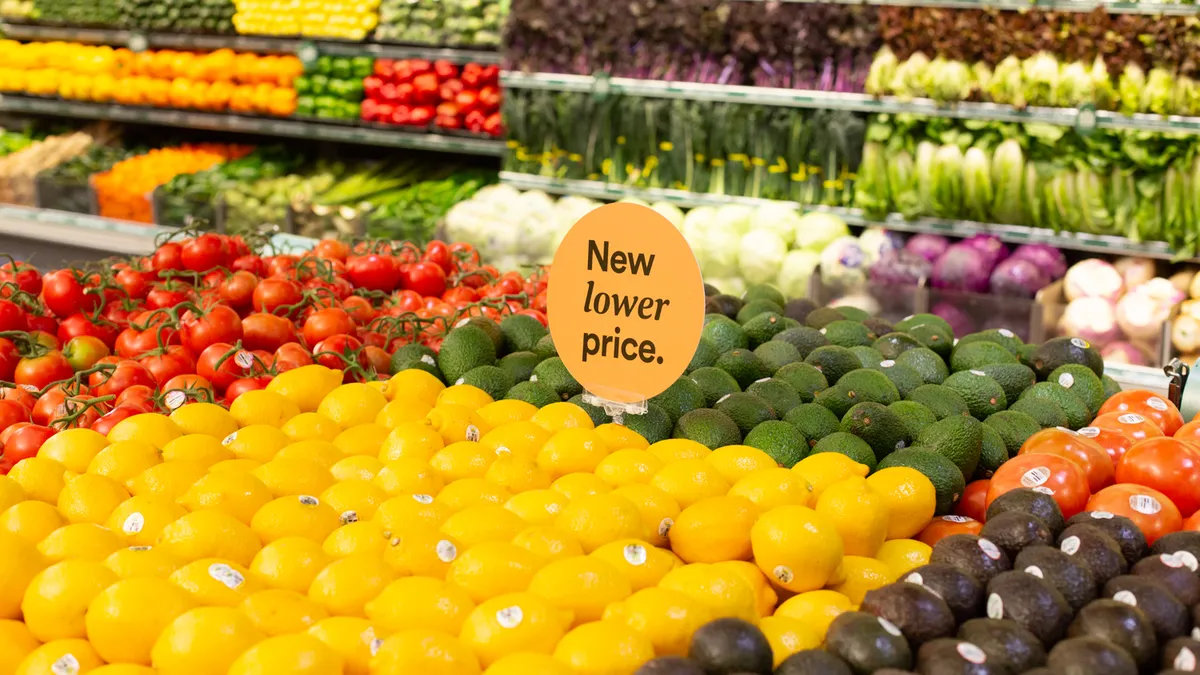Dive Brief:
- Amazon will cut prices on hundreds of products at Whole Foods beginning Wednesday, according to a press release from the grocer. This is the third round of price cuts since Amazon first acquired Whole Foods in 2017, and according to a Wall Street Journal report they will last through the end of this year.
- Whole Foods will reduce prices by an average of 20% on select items throughout the store, with an emphasis on peak-of-season produce, the company said. Large yellow mangos will be priced at $1 each, a 12-ounce carton of mixed-medley cherry tomatoes will be priced at $3.49 and a bunch of organic rainbow chard will be $1.99.
- Prime members will receive double the weekly discounts, with more than 300 Prime deals expected in the next few months. In April, Prime members will see deals such as 35% off sustainable, wild-caught halibut fillets, a $2 price drop to $2.99 per pound on organic strawberries and 20% off sandwiches and wraps. Beginning Wednesday and lasting until the end of the month, Whole Foods will also offer $10 off any order of $20 or more to customers who sign up for Prime.
Dive Insight:
After its acquisition of Whole Foods in 2017, Amazon introduced a sweeping lineup of lower prices on Whole Foods products. From Whole Trade bananas and organic avocados to animal-welfare-rated ground beef and almond butter, grocery staples were discounted by as much as 43%, according to Bloomberg.
The low prices didn’t last long, with some shooting back up just a couple months later. Since then, Whole Foods and Amazon have received criticism for their subpar efforts to further slash prices. The companies have touted weekly specials and lower prices on hundreds of products, but a September analysis from Gordon Haskett showed that a basket of Whole Foods groceries was only $1.50 cheaper than before the acquisition. Last month, The Wall Street Journal noted that Whole Foods prices had increased again, with the company citing inflation costs.
Amazon Prime members have fared better when it comes to the price of Whole Foods groceries, with an extra 10% off sale items and member-only discounts on a variety of products. Amazon is pumping up its Prime enticements with the $10-off deal — a reminder of how heavily invested Amazon is in driving its core membership base to stores and bringing more shoppers into its Prime ecosystem.
So far, research shows the integration of Prime hasn't been as potent as many predicted. According to a recent survey from Wolfe Research, only 5% of Prime members shop at Whole Foods several times a month, and 42% of Prime members say they never shop at Whole Foods.
Amazon’s announcement that it will launch its own grocery chain overshadows its efforts with Whole Foods to some degree, making it hard not to wonder what the e-tailer’s ultimate plans are with the natural grocer. Is it a testing ground for pricing at its new grocery store, or a way to identify what products are most popular? The company is also mining valuable shopper data from Whole Foods customers, and could be using that information to help shape its new offering.
Strengthening its brick-and-mortar footprint, whether through Whole Foods or its new grocery chain, is imperative for Amazon. Wolfe Research found that online purchasing penetration may be reaching capacity, with 44% of people reporting there were no categories in which they planned to increase online spending next year. This is particularly challenging for online food sales, which have not gained major traction compared to other retail industries, and could signify future challenges for Amazon’s online grocery offerings.
Whole Foods has long struggled with its high-priced reputation, which doesn’t necessarily align with Amazon’s low-price offerings across grocery and numerous other categories. If Amazon can consistently keep Whole Foods pricing in line with the discounts it offers through Prime and on Amazon.com, it could start to build more customer loyalty.
The latest round of price cuts could help attract more shoppers who avoided "Whole Paycheck" prices, especially if they have a Prime membership. But with Amazon’s shaky track record on holding prices down at Whole Foods, it could be tough to convince customers to make the switch.













